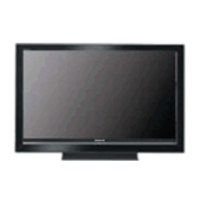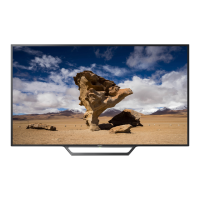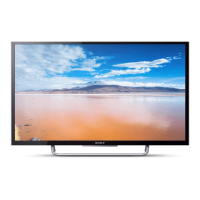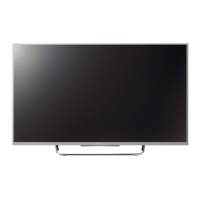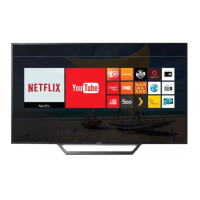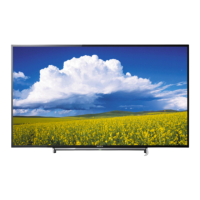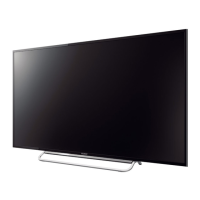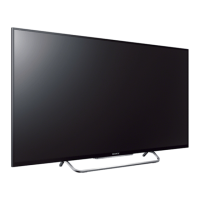
Do you have a question about the Sony Bravia KDL-46S4100 and is the answer not in the manual?
| Screen Size | 46 inches |
|---|---|
| Resolution | 1920 x 1080 |
| Display Technology | LCD |
| Backlight Type | CCFL |
| HDMI Ports | 3 |
| Component Video Inputs | 2 |
| Composite Video Inputs | 1 |
| Refresh Rate | 60Hz |
| Aspect Ratio | 16:9 |
| Audio Output | 10W + 10W |
| Weight | 58.4 lbs |
| Inputs | HDMI, Component, Composite, RF |
| Speakers | 2 |
Section for recording TV model and serial numbers for dealer reference.
Essential precautions for safe TV operation, plug use, and disconnection.
Guidance on TV placement, ventilation, and using correct mounting hardware.
Compliance with FCC rules and handling of radio frequency interference.
Comprehensive safety guidelines for TV operation, placement, power cord, and accessories.
Guidance on servicing, unplugging during storms, and handling damaged units.
Advises against exposing the TV to liquids to prevent fire or electric shock.
Details on cleaning the TV cabinet and LCD screen safely with appropriate materials.
Explains the importance of ventilation openings and how to maintain them for cooling.
Step-by-step instructions for safely carrying the TV, emphasizing proper grip.
Guidance on TV placement, avoiding hazards, and securing it to prevent toppling.
Advises against use in medical settings, outdoors, or vehicles due to risks.
Caution regarding magnetic fields from speakers affecting nearby items.
Details on using wall-mount brackets and contractor recommendations.
Precautions for handling AC cords, plugs, outlets, and maintenance.
Recommends using specified accessories and keeping small items away from children.
Guidelines for battery replacement, disposal, and avoiding hazards.
Explains normal pixel variations, brightness, and behavior in cold.
Precautions against direct sunlight, scratching, and contact with specific materials.
Instructions for safely handling a broken LCD panel, avoiding contact with glass and liquid.
Warns against self-servicing due to high voltage and refers to qualified personnel.
Post-servicing safety checks and notice regarding mercury disposal.
Welcomes the user and guides them to check accessories.
Explains the difference in picture quality and aspect ratios between HD and SD signals.
Details 16:9 aspect ratio for HDTV and 4:3 for standard TV, including black bars.
Instructions for taking out the table-top stand and placing it on a stable surface.
How to slide the TV onto the stand and attach it securely with screws.
How to connect cable or antenna for digital and analog programming.
Instructions for using an A-B RF switch for cable and antenna connections.
Diagram showing connection of HD box/satellite box to TV via HDMI.
Diagram showing connection of HD box/satellite box to TV via DVI with audio.
How to connect via component video and PC inputs.
Diagrams showing connections for PC, Blu-ray, VCR, game systems, and camcorders.
Details on HDMI inputs, including DVI to HDMI adapter usage.
How to connect composite video and audio from camcorders or game equipment.
Connecting S-Video, Composite video/audio, and Component video/audio.
Connecting PC, digital audio out, and analog audio out.
Measures to prevent TV toppling, including securing to wall/stand.
Guidance on using a specified Sony TV stand and following its manual.
Using angle braces to secure the stand to the wall stud.
Using anchor bolts, screws, or rope/chain to secure the TV to the stand.
Using anchor bolts and rope/chain to secure the TV to the wall stud.
Instructions on bundling connecting cables with the supplied cable band, avoiding the power cord.
Step-by-step guide to perform initial setup for language and channel scanning.
How to run Auto Program later for channel scanning after changing settings.
Explains functions of DISPLAY, SLEEP, FAVORITES, PICTURE, RETURN, MENU buttons.
Explains functions of CC, VOL+/-, MUTING buttons and number pad.
Describes how to turn the TV on/off and cycle through Wide Mode settings.
Visual guide to adjusting screen aspect ratios for different source types.
How to select inputs, access Tools Menu, use PIP, and change channels.
Functionality of JUMP and CH+/- buttons for channel navigation.
Operation of MENU, INPUT, VOLUME buttons on the TV set.
Function of POWER/STANDBY LEDs and IR receiver on the TV.
Explains how the MENU button provides intuitive TV control.
Details on Vivid, Standard, and Custom picture modes.
How to adjust backlight, contrast, brightness, color, and sharpness.
Options for Dynamic, Standard sound modes and Clear Voice.
How to adjust treble, bass, balance, and MTS/Stereo settings.
Adjusting screen aspect ratio and auto-wide function for different sources.
Setting default aspect ratio and adjusting display area for various resolutions.
Adjusting screen for PC input, including wide mode and auto adjustments.
Adjusting phase, pitch, center, and power saving for PC input.
Setting favorite channels, configuring cable input, and adding digital channels.
Running auto program, showing/hiding channels, and labeling channels.
Setting parental ratings and digital rating blocks based on content.
Blocking unrated programs, channels, or external inputs with a password.
Selecting custom rating options for US models, including movie and TV ratings.
How to temporarily disable parental controls using a password to view blocked programs.
Selecting custom rating options for Canadian models, including French and English ratings.
Configuring closed captions modes and displaying program information banners.
Assigning custom labels to video inputs for easier identification.
Adjusting power saving modes and viewing product information.
Detailed settings for basic, digital, and advanced closed caption customization.
Solutions for problems like no channels received or TV locked to one channel.
Troubleshooting steps for double images, noise, incorrect color, or dim pictures.
Solutions for no sound, audio noise, and automatic Wide Mode changes.
Troubleshooting for black boxes, black bands, loss of detail, and remote control issues.
Procedure for resetting the TV to factory defaults, clearing all settings.
Steps for removing the table-top stand and installing the wall-mount bracket.
Emphasizes expertise and contractor use for safe wall mounting.
Advice on safely storing removed stand components and screws.
Chart detailing compatible PC resolutions, frequencies, and standards.
Advice on using specific signals and settings for optimal picture quality.
Details on TV system standards, NTSC, ATSC, and channel coverage.
Technical specifications for LCD panel, video/audio inputs, and connectors.
Specifications for power consumption, dimensions, weight, and included/optional accessories.
Provides contact information for Sony customer support via website and phone.
Overview of connector types and their impact on audio/video performance.
Steps to select language and initiate the automatic channel scanning process.
Diagrams for connecting TV to home theater, VCR/DVD, and PCs.
Sony's advice to customers regarding professional installation of brackets/stands.
Checking parts, deciding location, and installing the base bracket.
Steps to prepare the TV and attach it to the wall mount.
Spanish instructions for preparing TV installation and securing the mounting hook.
Spanish instructions for final wall mounting of the TV.
Table showing TV dimensions and screen center point for installation planning.
Diagrams indicating screw and hook positions for wall mounting.
Terms and conditions for using free software components.
Notice regarding FCC transition to digital broadcasting and its effect on the TV.
Encourages product registration for warranty, loss/theft records, and product updates.
Details on what the limited warranty covers, exclusions, and duration.
Instructions on how to get warranty service, including contact numbers and web resources.

